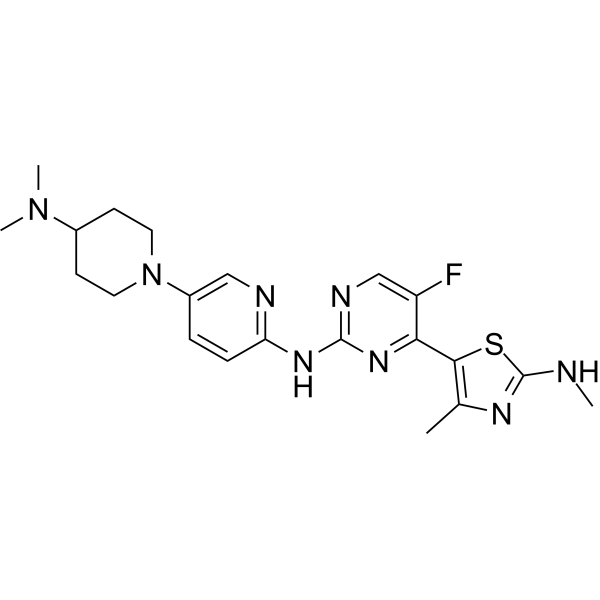Physicochemical Properties
| Molecular Formula | C21H27FN8S |
| Molecular Weight | 442.556084871292 |
| Exact Mass | 442.206 |
| CAS # | 2078047-99-9 |
| PubChem CID | 135286280 |
| Appearance | Light yellow to yellow solid powder |
| LogP | 3.6 |
| Hydrogen Bond Donor Count | 2 |
| Hydrogen Bond Acceptor Count | 10 |
| Rotatable Bond Count | 6 |
| Heavy Atom Count | 31 |
| Complexity | 564 |
| Defined Atom Stereocenter Count | 0 |
| SMILES | S1C(NC)=NC(C)=C1C1=C(C=NC(=N1)NC1=CC=C(C=N1)N1CCC(CC1)N(C)C)F |
| InChi Key | NAGFLZVMWVHHLW-UHFFFAOYSA-N |
| InChi Code | InChI=1S/C21H27FN8S/c1-13-19(31-21(23-2)26-13)18-16(22)12-25-20(28-18)27-17-6-5-15(11-24-17)30-9-7-14(8-10-30)29(3)4/h5-6,11-12,14H,7-10H2,1-4H3,(H,23,26)(H,24,25,27,28) |
| Chemical Name | 5-[2-[[5-[4-(dimethylamino)piperidin-1-yl]pyridin-2-yl]amino]-5-fluoropyrimidin-4-yl]-N,4-dimethyl-1,3-thiazol-2-amine |
| HS Tariff Code | 2934.99.9001 |
| Storage |
Powder-20°C 3 years 4°C 2 years In solvent -80°C 6 months -20°C 1 month |
| Shipping Condition | Room temperature (This product is stable at ambient temperature for a few days during ordinary shipping and time spent in Customs) |
Biological Activity
| Targets | CDK4 3 nM (IC50) CDK6 0.279 μM (IC50) CDK2 3.335 μM (IC50) |
| ln Vitro | Furthermore, CDK4/6-IN-15 (compound 91) (10 μM; 24 h) potently suppresses MYLK4 and FLT3 with >90% inhibition rates.[1]. With GI50s of 0.107 μM (MV4-11) and 0.325 μM (MDA-MB-453), CDK4/6-IN-15 (0-5 μM; 72 h) selectively inhibits the growth of tumor cells[1]. In Rb-positive MV4-11 and MDA-MB-453 cells, CDK4/6-IN-15 (0.1–1 μM; 24 h) solely stops the cell cycle at the G1 phase[1]. MV4-11 and MDA-MB-453 cells undergo apoptosis in response to CDK4/6-IN-15 (0.1-1 μM or 0.3-3 μM; 24-96 h)[1]. Rb phosphorylation is inhibited by CDK4/6-IN-15 (0.1-3.3 μM; 4-24 h)[1]. |
| ln Vivo | CDK4/6-IN-15 (compound 91) exhibits oral comparable absorption in adult male BALB/c mice (20–25 g) in good health, as well as in male albino Wistar rats (250–350 g) (5 mg/kg for iv or 200 mg/kg for po; single dose)[1]. Path Dose (mg/kg) CL (mL/min /kg) Vss (L/kg) AUC (μM·h) Cmax (μM) Tmax (h) t1/2 (h) F (%) rat IV 5 155 27.5 1.2 1.4 / 2.1 / PO 20 / / 4.4 0.3 4.3 20.3 95 mouse IV 2 90 15.7 0.7 1.3 / 2.9 / PO 10 / / 4.3 0.6 2.5 2.7 129 [pharmacokinetic Analysis] |
| Cell Assay |
Apoptosis Analysis[1] Cell Types: MV4-11 and MDA-MB-453 cells Tested Concentrations: 0.1 μM, 0.5 μM, and 1 μM for MV4-11; 0.3 μM, 0.6 μM, and 3.3 μM for MDA-MB-453 cells Incubation Duration: 24 h, 48 h, 72 h, and 96 h Experimental Results: Induced cell apoptosis via arresting cell cycle at G1 accompanied with Rb) phosphorylation suppression and E2F- regulated gene expression decreases. Western Blot Analysis[1] Cell Types: MV4-11 (GI50=0.107 μM) and MDA-MB-453 (GI50=0.325 μM) Tested Concentrations: 1×, 5×, 10× GI50 Incubation Duration: 4 h, 12 h, and 24 h Experimental Results: Resulted inhibition of Rb phosphorylation at S780. |
| References |
[1]. Discovery and pharmacological characterization of a novel series of highly selective inhibitors of cyclin-dependent kinases 4 and 6 as anticancer agents. Br J Pharmacol. 2018 Jun;175(12):2399-2413. |
Solubility Data
| Solubility (In Vitro) | DMSO : 5 mg/mL (11.30 mM) |
| Solubility (In Vivo) |
Solubility in Formulation 1: ≥ 0.5 mg/mL (1.13 mM) (saturation unknown) in 10% DMSO + 90% Corn Oil (add these co-solvents sequentially from left to right, and one by one), clear solution. For example, if 1 mL of working solution is to be prepared, you can add 100 μL of 5.0 mg/mL clear DMSO stock solution to 900 μL of corn oil and mix evenly. (Please use freshly prepared in vivo formulations for optimal results.) |
| Preparing Stock Solutions | 1 mg | 5 mg | 10 mg | |
| 1 mM | 2.2596 mL | 11.2979 mL | 22.5958 mL | |
| 5 mM | 0.4519 mL | 2.2596 mL | 4.5192 mL | |
| 10 mM | 0.2260 mL | 1.1298 mL | 2.2596 mL |
